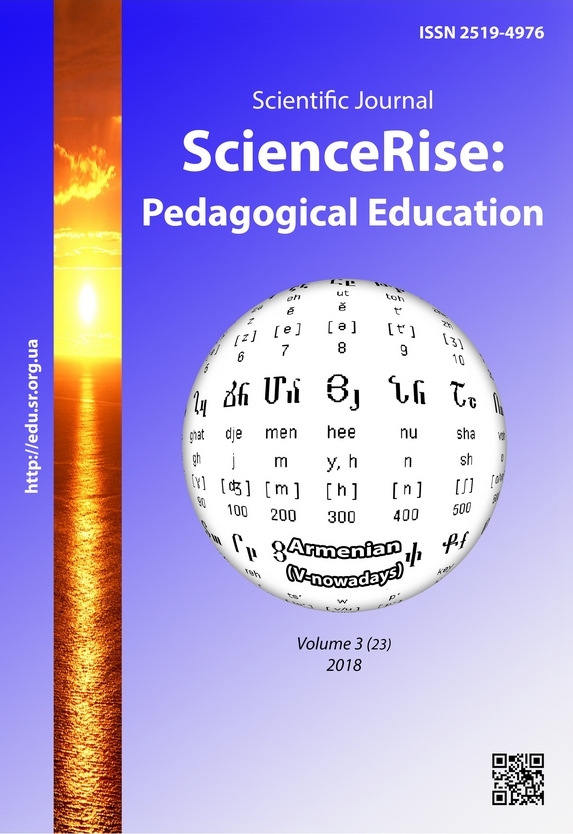State programs for organizing the training of future doctors in higher medical education institutions of Great Britain
DOI:
https://doi.org/10.15587/2519-4984.2018.126411Keywords:
higher medical education, organization of doctor's training, state programs, professional trainingAbstract
The article analyzes state programs for organizing the professional training of future doctors in higher education institutions in the UK. During the last years, vocational education and training have become one of the fastest developed sectors of the economy of western countries. The dynamic process of social development is closely linked to the rapid changes in the quantitative parameters of national education systems and the updating of public training periods for future employees. For the UK there is a characteristic advanced qualification system. Youth education is carried out in accordance with the state program "Professional Youth Training", designed for high school graduates aged 16–17 years. The purpose of the program is the in-depth training of young people. Graduates are tested on four indicators: compliance with the requirements of narrow specialization and qualification requirements of the profession, the ability to apply knowledge in new conditions, business qualities. In the UK, internships at enterprises within the framework of the state "Youth Assistance Program" are supplemented by theoretical seminars at special courses.
The modern approach to training and retraining of labor potential, which is used in British education, is characterized by a variety of content, forms and methods of work, an increase in the professional level of specialists in human resources management services, an increase in the proportion of funds spent on these goals using the latest technologies. Economic, administrative and moral factors are used to encourage employees to study in the studied country
References
- General Medical Council of Great Britain. Available at: https://www.gmc-uk.org/about/devolved_offices.asp
- Qualifications in Great Britain (2008, November). The frame work for higher education qualifications in England, Wales and Northen Irland Report. Available at: http://www.enic-naric.net/framework-of-qualifications-in-the-europe-and-north-america-region.aspx
- Peile, E., Buckle, G., Gallen, D. (2003). Higher professional Educationfor General Practitioners. Abingdon: Radcliff Medical Press Ltd, 179.
- Babushko, S. R.; Lukianova, L. B. (Ed.) (2015). Profesiinyi rozvytok fakhivtsiv sfery turyzmu v SShA ta Kanadi. Kyiv-Nizhyn: Vydavets PP Lysenko M. M., 424.
- Bidiuk, N. M. (2009). Teoriia i praktyka profesiinoho navchannia bezrobitnykh u SSHA. Kyiv, 544.
- Zdravookhranenie v Velikobritanii, Frantsii, SSHA. Available at: https://www.kaktam.info/2014/02/12/здравоохранение-в-великобритании/
- GMC Our role in education and training. Available at: https://www.gmc-uk.org/education/27007.asp
- Helping to raise standards through revalidation. Available at: https://www.gmc-uk.org/about/role.asp
- Investigating and acting on concerns about doctors. Available at: https://www.gmc-uk.org/about/role.asp
- Tretko, V. V. (2013). Profesiina pidhotovka mahistriv mizhnarodnykh vidnosyn u Velykii Brytanii: teoriia i praktyka. Khmelnytskyi: KhNU, 414.
- Department for Education. Available at: http://www.dfes.gov.uk
- Education Reform Act. A decade of reformsact compulsory education level (1984–1994) (1997). Brussels-Luxemburg: Office for Official Publications of the European Communities, 316.
- Overseeing doctors' education and training. Available at: https://www.gmc-uk.org/about/role.asp
Downloads
Published
How to Cite
Issue
Section
License
Copyright (c) 2018 Kamilla Magrlamova

This work is licensed under a Creative Commons Attribution 4.0 International License.
Our journal abides by the Creative Commons CC BY copyright rights and permissions for open access journals.
Authors, who are published in this journal, agree to the following conditions:
1. The authors reserve the right to authorship of the work and pass the first publication right of this work to the journal under the terms of a Creative Commons CC BY, which allows others to freely distribute the published research with the obligatory reference to the authors of the original work and the first publication of the work in this journal.
2. The authors have the right to conclude separate supplement agreements that relate to non-exclusive work distribution in the form in which it has been published by the journal (for example, to upload the work to the online storage of the journal or publish it as part of a monograph), provided that the reference to the first publication of the work in this journal is included.








